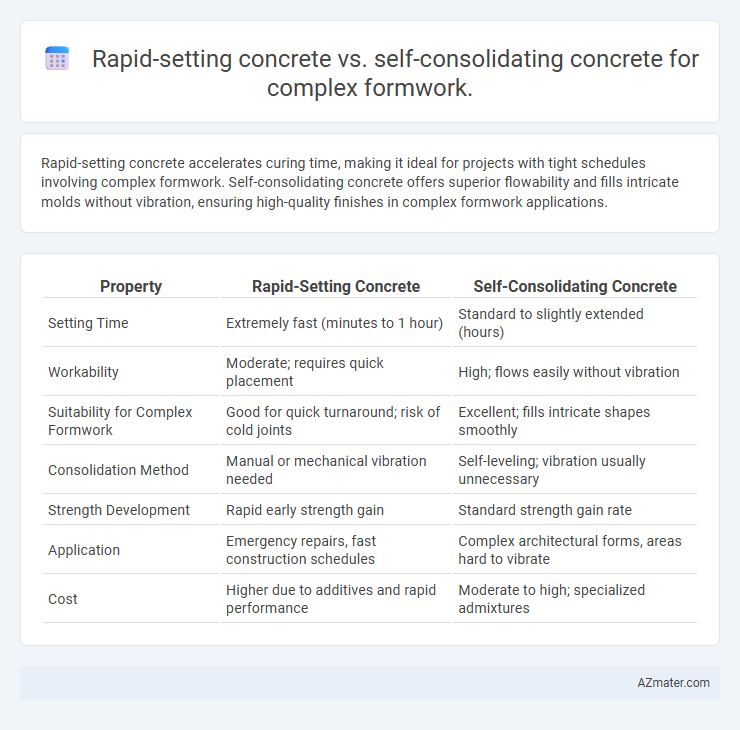Rapid-setting concrete accelerates curing time, making it ideal for projects with tight schedules involving complex formwork. Self-consolidating concrete offers superior flowability and fills intricate molds without vibration, ensuring high-quality finishes in complex formwork applications.
Table of Comparison
| Property | Rapid-Setting Concrete | Self-Consolidating Concrete |
|---|---|---|
| Setting Time | Extremely fast (minutes to 1 hour) | Standard to slightly extended (hours) |
| Workability | Moderate; requires quick placement | High; flows easily without vibration |
| Suitability for Complex Formwork | Good for quick turnaround; risk of cold joints | Excellent; fills intricate shapes smoothly |
| Consolidation Method | Manual or mechanical vibration needed | Self-leveling; vibration usually unnecessary |
| Strength Development | Rapid early strength gain | Standard strength gain rate |
| Application | Emergency repairs, fast construction schedules | Complex architectural forms, areas hard to vibrate |
| Cost | Higher due to additives and rapid performance | Moderate to high; specialized admixtures |
Introduction to Complex Formwork Challenges
Complex formwork presents challenges such as intricate shapes, tight reinforcement spacing, and limited access, requiring concrete that flows easily yet sets reliably. Rapid-setting concrete offers accelerated strength gain, minimizing formwork removal time but demands precise placement to avoid cold joints and defects. Self-consolidating concrete excels in filling complex molds without vibration, ensuring uniformity and surface quality while accommodating congested reinforcement.
Overview of Rapid-setting Concrete
Rapid-setting concrete offers a fast hardening time, typically achieving initial set within 30 minutes, making it ideal for projects with tight schedules or early load requirements. Its composition includes high cement content, accelerators, and fine aggregates to promote quick strength gain while maintaining durability and workability. This type of concrete is especially effective in complex formwork situations where minimizing form removal time and reducing downtime are critical for construction efficiency.
Key Characteristics of Self-consolidating Concrete
Self-consolidating concrete (SCC) exhibits exceptional flowability and high deformability allowing it to fill intricate and dense reinforcement configurations without mechanical vibration, making it ideal for complex formwork. SCC's key characteristics include superior workability, segregation resistance, and enhanced surface finish, which improve construction speed and quality in demanding structural applications. The mix design incorporates fine fillers and viscosity-modifying agents to maintain homogeneity and prevent bleeding, ensuring consistent performance in challenging formwork geometries.
Performance in Intricate Formwork Designs
Rapid-setting concrete offers accelerated strength gain, enabling faster removal of complex formwork and reducing construction time in intricate designs. Self-consolidating concrete (SCC) excels in flowability and high deformability, ensuring complete filling of intricate molds without the need for vibration, which preserves delicate details and provides superior surface finish. While rapid-setting concrete prioritizes early strength, SCC optimizes workability and dimensional accuracy critical for complex and detailed formwork applications.
Workability and Placement Techniques
Rapid-setting concrete offers accelerated strength gain, making it ideal for time-sensitive projects with complex formwork, but requires precise timing in mixing and placement to ensure workability before it hardens. Self-consolidating concrete (SCC) provides superior flowability and filling capacity without the need for vibration, enabling effortless placement around intricate shapes and densely packed reinforcement in complex formworks. The high deformability and segregation resistance of SCC reduce labor intensity and improve surface finish quality, while rapid-setting concrete demands skilled handling to balance quick setting with adequate workability.
Setting Time and Construction Speed
Rapid-setting concrete cures within 30 to 60 minutes, enabling faster demolding and quicker progression in projects with complex formwork. Self-consolidating concrete offers high flowability and excellent filling capacity without vibration, reducing labor time but has a longer setting time of 2 to 4 hours. For construction speed in intricate molds, rapid-setting concrete outperforms due to its quick strength gain, while self-consolidating concrete excels in achieving defect-free finishes with moderate setting periods.
Surface Finish and Defect Prevention
Rapid-setting concrete offers fast strength gain, allowing early formwork removal and reduced risk of surface defects due to timely stripping, but may require careful curing to prevent cracking or shrinkage. Self-consolidating concrete excels in complex formwork with its high flowability and segregation resistance, producing smooth, uniform surface finishes without the need for vibration and minimizing honeycombing or air voids. Optimal defect prevention in complex molds depends on balancing rapid strength development with the concrete's rheology to achieve both durability and aesthetic quality.
Durability and Long-term Performance
Rapid-setting concrete offers accelerated strength gain ideal for quick turnaround in complex formwork but may exhibit increased shrinkage and potential durability concerns under long-term exposure to freeze-thaw cycles. Self-consolidating concrete provides superior flowability and homogeneity, reducing voids and enhancing overall durability with improved resistance to chemical attack and cyclic loading. Long-term performance of self-consolidating concrete typically surpasses rapid-setting mixes due to its refined microstructure and reduced permeability in intricate mold geometries.
Cost Analysis and Material Efficiency
Rapid-setting concrete reduces labor costs and accelerates project timelines with its fast curing time, minimizing formwork turnover delays in complex structures. Self-consolidating concrete enhances material efficiency by eliminating the need for vibration and improving flowability, thereby reducing labor-intensive processes and minimizing voids or defects in intricate formworks. Although rapid-setting concrete generally incurs higher initial material costs, its shorter curing period often results in overall cost savings, while self-consolidating concrete lowers rework expenses and optimizes material usage, making both options viable depending on project priorities.
Choosing the Right Concrete for Your Project
Rapid-setting concrete offers accelerated strength gain ideal for projects with tight schedules and quick formwork removal, while self-consolidating concrete excels in filling intricate, complex formwork without mechanical vibration, ensuring high-quality surface finishes and minimal segregation. Selecting the right concrete depends on project priorities such as curing time, structural complexity, and labor availability; rapid-setting concrete suits urgent repairs and fast-track construction, whereas self-consolidating concrete is preferred for architectural elements requiring precision and smooth detail replication. Evaluating factors like set time, flowability, and formwork complexity ensures optimal performance and durability in your concrete application.

Infographic: Rapid-setting concrete vs Self-consolidating concrete for Complex formwork
 azmater.com
azmater.com